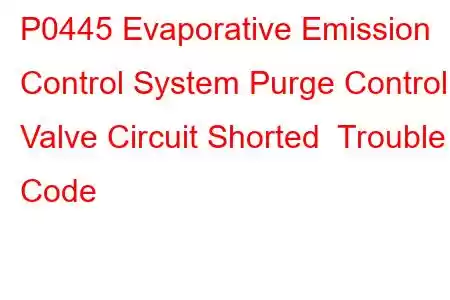P0445 Evap. Purge Control Valve Circuit Shorted
OBD-II Trouble Code Technical Description
Evaporative Emission Control System Purge Control Valve Circuit Shorted
This diagnostic trouble code (DTC) is a generic OBD-II powertrain code. It is considered generic because it applies to all makes and models of vehicles (1996-newer), although specific repair steps may vary depending on the model.
What does that mean?
On vehicles equipped with Evaporative emission control systems also known as EVAP, the engine draws in excessive fuel vapors from the gas tank that would otherwise be vented into the atmosphere.
The fuel vapor is routed through a vacuum line to the engine's intake and the purge valve/solenoid meters the desired amount of fuel vapors, controlled by the vehicles powertrain control module (PCM) or engine control module (ECM). The PCM/ECM monitors the voltage to the purge control valve and has detected a lower voltage than expected.
Note: This code is similar to codes P0443 and P0444.
Symptoms
Symptoms of a P0445 trouble code may include:
Check engine light on (Malfunction indicator lamp illuminated) Slightly diminished fuel economy, this will not affect engine performancePotential Causes
Causes of this DTC may include:
Engine wiring harness or connector short circuit Purge control solenoid short circuit PCM/ECM malfunctionDiagnostic Steps for P0445 DTC
Engine wiring harness - Inspect wiring harness connectors for damage, look for pinched wires, loose or bent pins or bare wiring with no insulation. Typically the purge control valve is energized by the the battery and triggered on and off with a duty cycle through the PCM/ECM. Using the manufacturers wiring diagrams, identify which type of circuit being used and check for battery voltage presence with the key on/engine off at the power side of the control solenoid connector using a digital volt ohm meter (DVOM) set to the volts scale. If no battery voltage is present, trace the wiring back to determine the cause.
Check for a short to ground by disconnecting the harness at the control valve solenoid and the source of voltage. Using the DVOM set to the ohms scale, with the negative lead connected to a known good ground and the positive lead on either end that supplies power to the control valve solenoid. If resistance is very low, suspect a short to ground and repair the wiring harness. Check for a short to ground on the control side of the harness by disconnecting the harness from the control valve solenoid and the PCM/ECM harness. Identify the correct wire and using the DVOM set to ohms scale, check for resistance with the negative lead connected to a known good ground and the positive lead on either wire harness for the control circuit. If resistance is very low, suspect a short to ground and repair the wiring harness.
Purge control solenoid - Check for continuity at the purge control solenoid connector pins after removing the harness plug using the DVOM set to the ohms scale. Verify resistance is within manufacturers specifications. Check for a short to ground using the DVOM with the negative lead attached to a known good ground and the positive lead on each of the terminal pins to the control valve solenoid. Resistance should be very high or over limit (OL). If there is a very low amount of resistance found, suspect the control valve solenoid is shorted to ground and replace with a known good unit.
PCM/ECM malfunction - Since the EVAP is only turned on during certain driving conditions, it will be necessary to monitor the EVAP control operation using an advanced scan tool capable and performing a road test under the driving conditions required to activate the EVAP system. Some advanced scan tools have an internal test to activate the EVAP system manually. Verify the PCM/ECM is commanding the EVAP system on. If the system is functioning correctly, it will be necessary to back probe the PCM/ECM wiring harness connector using a graphing multimeter or oscilloscope with a duty cycle feature with the positive lead on the purge control valve pin and the negative lead connected to a known good ground. The duty cycle should match what is commanded on by the PCM/ECM during EVAP operation. If there is no duty cycle present, the PCM/ECM may be at fault.
Other EVAP DTCs: P0440 - P0441 - P0442 - P0443 - P0444 - P0446 - P0447 - P0448 - P0449 - P0452 - P0453 - P0455 - P0456
Read: 45


